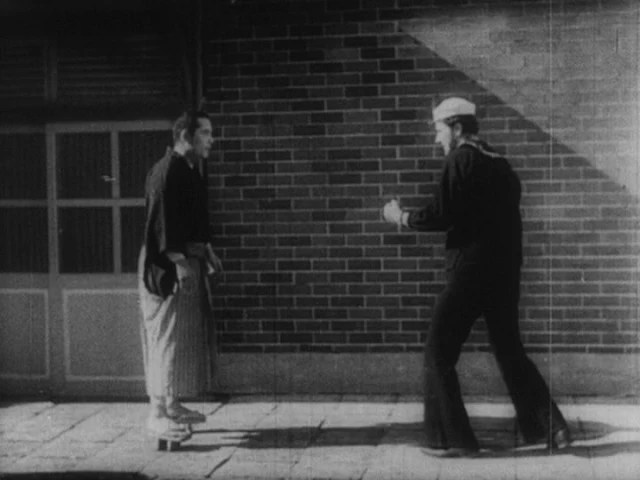 |
| Pierre Fresnay in La Main du Diable |
Irène: Josseline Gaël
Mélisse: Noël Roquevert
Gibelin: Guillaume de Sax
The Little Man: Palau
Angel: Pierre Larquey
The Diner: André Gabriello
Denis: Antoine Balpêtré
Mme. Denis: Marcelle Rexiane
The Colonel: André Varennes
Duval: Georges Chamarat
The Musketeer: Jean Davy
The Boxer: Jean Despreaux
Maximus Léo: André Bacqué
The Fortune Teller: Gabrielle Fontan
Director: Maurice Tourneur
Screenplay: Jean-Paul Le Chanois
Based on a novel by Gérard de Nerval
Cinematography: Armand Thirard
Production design: Andrej Andrejew
Film editing: Christian Gaudin
Music: Roger Dumas
Maurice Tourneur's son, Jacques Tourneur, is better-known in the United States today because of his work for producer Val Lewton on arty horror films like Cat People (1942) and I Walked With a Zombie (1943), as well as the quintessential film noir Out of the Past (1947). Maurice had been a mainstay Hollywood director in the silent era -- director Clarence Brown named him as one of his mentors -- but grew impatient with studio interference and returned to France just as sound was coming in. As a result, La Main du Diable (released in the States as Carnival of Sinners) is probably his best-known film on this side of the Atlantic. It shares with his son's films a stylish approach to horror filmmaking, in which creating a mood takes precedence over shocking the audience. Based on a story by Gérard de Nerval, La Main du Diable is about a struggling artist, Roland Brissot, who buys a talisman, a severed hand in a casket, from a chef, paying only a penny for it. The chef claims that it has made him a success, but that it must be sold again, at less than the price Brissot paid him for it, before the artist dies. Otherwise his soul will be lost forever. Brissot's career takes off, making him rich, and he marries his model, Irène, who had hitherto spurned him. But he soon finds that he's being stalked by a little man in black, the devil himself, who makes it clear that the talisman is the real thing and offers to buy it back from Brissot, who is unable to sell it because there's no coin smaller than the penny he had paid. The artist, enjoying his celebrity and wealth, turns him down, but is then informed that since the buyback offer has been made, the price will double each day. Soon the price has mounted into the millions and Brissot begins to panic, looking for a way to get rid of the hand. He then learns the lineage of the hand, which began several centuries ago with a deal made by a monk named Maximus Léo -- which is also the name Brissot, under the spell of the hand, has been signing to his paintings. If Brissot can reunite the hand with the monk's body, then the deal can be broken. All of this is told in flashback to a crowd at the inn in the French Alps to which Brissot has traveled, the little man in black pursuing him, trying to find the tomb of Maximus Léo. There's not really much horror on display in La Main du Diable, but the film is full of striking visuals, the work of production designer Andrej Andrejew and cinematographer Armand Thirard, and Tourneur directs a capable and colorful cast headed by Pierre Fresnay as Brissot. Since the film was made in occupied France, there are those who think it's a subversive allegory about the price exacted from the French in capitulating to the Nazis.








